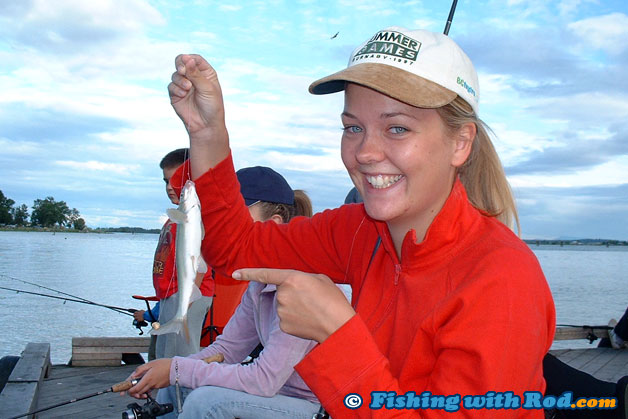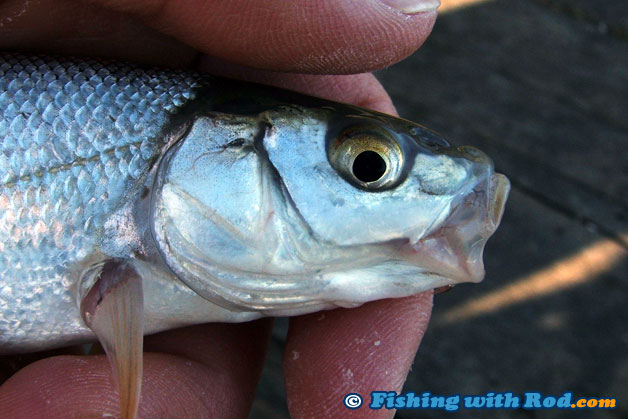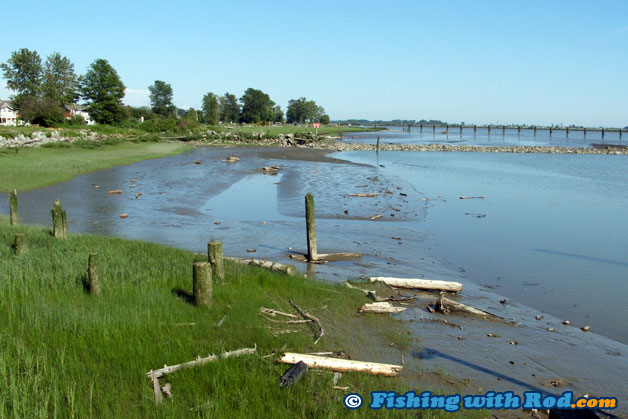Improving Your Tidal Fraser Coarse Fish Catches
By Rodney Hsu, Fishing with Rod | Published in May 2007

Although they are plentiful and many anglers feel the challenge of catching them does not exist, targeting coarse fish in the Tidal Fraser River successfully can be a frustrating process if the angler lacks experience. If the techniques are practiced and adjusted, then those tiny quick bites can easily be transformed into multiple hook-ups. This article is aimed to guide adults who would like to introduce children into fishing without having them intimidated by improving the hook-up ratio.
Having the Correct Equipment

Correct equipment that does the job properly is crucial in all activities. In fishing, the equipment must fit the user properly and be adequate for the size of the target species. Pricy rods and reels are not necessary. In fact, they are useless if they are not designed for the fish that you are trying to catch. Although you do not need to invest much financially on coarse fishing tackle, it is advantageous to spend some time when picking out what you and your family would like to use. This process often involves enquiring store employees who usually have had experience on the tackle that you are looking for.
A salmon or steelhead rod is definitely not suitable for peamouth chub. The rod is too stiff and heavy, therefore the bites would be undetected. Even if you manage to hook a fish, it would not be too noticeable as the fish is not big enough to bend a rod that is designed for much larger species. Typically, you should look for a spinning rod that is rated between 2 and 6lb test. Most brands of fishing rods carry models in this weight class. The rod should be no longer than 6 feet. Long rods simply add more weight, resulting in slower reaction time when setting the hook. The tip of the rod should be thin so those delicate bites can be detected.
A small spinning reel that has the spool capacity for 2 to 6lb test line should accompany this ultra-light rod. The spool capacity is usually labeled on the spool. Look for the smallest model that is available from your favorite brand, which is usually indicated by the smallest model number.
With a light rod and a small reel, it only makes sense to use small terminal tackle. Since your target species usually only weigh below 4lb, there is not a need to use fishing line that is rated more than 6lb test. Personally, I prefer spooling my reel with 6lb test as my main line, and choose the strength of my leader based on the species that I am targeting. Do not oversize your hook. Pay attention to the size of your fish's mouth. If the hook can't fit in it, then it is a good idea to try a smaller hook. When using a float, choose one that only requires several grams of weight to balance. I prefer to use a stick-style float than a round float. A thin float has less surface area, which reduces water resistance when a fish pulls it down.
Polishing Your Hook-set

Unlike predatory species such as salmon, trout and char, coarse fish feed like a goldfish. Algae and crustacean feeders such as peamouth chub prefer to "test" their food instead of swallowing with one gulp. Like a goldfish, they peck, suck, spit and repeat the process several times. This is translated into small rapid taps on the rod tip or gentle bobbing of the float. Beginners often do not hesitate and lift the rod up immediately, but usually they will find themselves with a hook that has nothing on it.
To increase your hook-up rate, it is best to wait until the fish commits fully to the bait. Small rapid taps should be ignored. You will find yourself being rewarded quite easily if you only set the hook when the taps on the rod tip are larger and slower. If you are using a float, set the hook when the entire float is underwater.
When setting the hook, keep in mind that the fish you are trying to catch are not big. If the hook-set is too hard, quite often the hook would be ripped out of the fish's mouth. The amount of force that should be applied can be determined after some practice.
To improve your hooking success, keep the bait size small. If the amount of bait placed on the hook is much larger than the hook, then you would end up feeding the fish instead of catching them. It is also important to leave the hook tip exposed for better hook-set.
Keeping Track of Your Depth

Freshwater minnow species expand their territory into the Tidal Fraser River in spring and summer when spring freshet dominates the system. In the Tidal Fraser River, the deep portion is made up of saltwater from Georgia Strait because it has a higher density than freshwater. The shallow and surface portion remains fresh. It is important to memorize these facts.
Since the area of the river closest to shore is made of freshwater, it is only logical to focus your fishing effort in these areas. You will be successful by casting your bait within meters from shore. If the bottom appears sandy, use a bottom rig. If it is fairly rocky, then a float is very advantageous.
Most of the fish, especially the larger ones, will inhabit the bottom of the water column, therefore you need to make sure your bait suspends just above the bottom. This can be easily done with a bottom rig. When using a float rig, keep the length between the float and the hook slightly shorter than the actual depth.
The last factor that you need to be concerned about is tide. The Lower Fraser River between Steveston and Chilliwack is affected by tide constantly. On days when strong tidal effect takes place, the water depth change can be as much as 4 meters in 6 hours. When water rises or drops, you need to be aware and keep changing your float depth. Fish are also likely to move when water movement is present, so you need to change your strategy at times to adapt.
Although coarse fishing is considered as child's play to many seasoned anglers, there are still many small useful details that you need to fish successfully. By remembering these and modifying them when the fish are not cooperating, you will have a great time fishing this summer!

